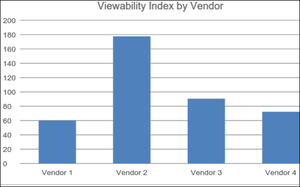It’s been awhile since we checked in with the team at independent trading desk Accordant Media, so I was delighted when Founder-CEO Art Muldoon offered a scoop on their
third-quarter marketplace report. It doesn’t make up for raiding former Real-Time Daily Editor Tyler Loechner, but we’ll take our scoops anywhere they come from. Seriously, the report has
some key insights.
You can read about the main one here, but
the other big one comes from Accordant’s “spotlight” on “viewability.” Yeah, I know that sounds redundant, but the sidebar really does shed light on the subject.
Basically, According conducted a side-by-side analysis of four Media Rating Council accredited viewability measurement firms. The Accordant team, being the gentlemen and gentle ladies they
are, didn’t name names, but anyone checking the MRC’s accreditation roster would find that they include comScore, DoubleVerify, Integral Ad Science and Moat.
advertisement
advertisement
It’s
not news that they each utilize different methods that produce different results, but the Accordant analysis sought to control for that with as many apples-to-apples as possible. The result looks more
like fruit salad.
Basically, Accordant controlled by comparing the four vendors results against the same exact impressions rendered in actual real-time market trading. The result:
Overall, the vendors only agreed on viewable impressions about 30% of the time, and when evaluating them based on the same exact impression, they only agreed 3.2% of the time.
While
that’s not exactly an indictment on each vendor’s methods or accuracy, it does point out that viewability is still very much in the eye of the beholder.
Aside from
creating marketplace confusion, Muldoon suggests it could also lead to some marketplace distortions, because the compunction of the supply-side -- and even some of those on the demand-side -- is to
utilize the metric that indexes the highest, not necessarily because it is the best. That’s always been true of media measurement, whether it was the battle over Nielsen and Arbitron local TV
ratings or MRI and Simmons magazine audience estimates decades ago. If you’re selling based on numbers, why wouldn’t you use the vendor that reports the highest ones?
Why
people on the demand-side would do that raises potentially even bigger industry issues that I don’t really want to go into detail about in this column, though I’ve written about it before.
And that has to do with how people on the demand-side -- agencies, traders, even people inside client marketing organizations -- are rewarded for procuring media. Sometimes, it’s just about the
numbers, not what they actually represent.
So I can
only guess who “Vendor 2” is in Accordant’s spotlight chart, but I’m going to venture that in terms of viewability measurement market share, they also index the highest.